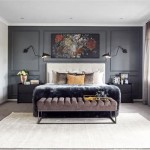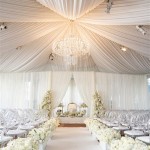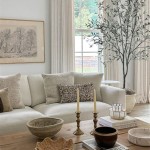How To Decorate a Small Room on a Budget
Decorating a small room can present unique challenges. Space is limited, and every design choice must be carefully considered to maximize functionality and create an aesthetically pleasing environment. However, achieving a stylish and comfortable small room does not require a significant financial investment. By employing strategic planning, resourceful shopping, and creative problem-solving, it is possible to transform a cramped area into a welcoming and personalized space without exceeding a predetermined budget.
The initial step in decorating any room, regardless of size or budget, involves careful planning. This stage encompasses assessing the room's existing features, determining the desired aesthetic, and establishing a realistic budget. It's crucial to identify the room's primary function and to consider how the decoration can contribute to that purpose. For example, a small bedroom might prioritize restful ambiance and efficient storage, while a small living room might focus on creating a comfortable and inviting social space.
Budget allocation is a critical aspect of this initial planning. It is recommended to create a detailed spreadsheet or list, categorizing expenses such as paint, furniture, accessories, and lighting. Prioritizing items based on necessity and impact helps to ensure that funds are allocated effectively. It is beneficial to research average prices for desired items and services to avoid overspending. Setting a contingency fund for unexpected expenses offers a buffer against potential budget overruns.
Before purchasing any new items, a thorough assessment of existing furniture and accessories is advisable. Repurposing or refurbishing existing items can significantly reduce expenses. A fresh coat of paint, new hardware, or creative reupholstering can breathe new life into old furniture. Similarly, decorative items such as picture frames, vases, and lamps can be repurposed or rearranged to create a new look without incurring any additional costs.
Maximizing Space with Strategic Furniture Choices
In a small room, furniture should serve a dual purpose: functionality and space optimization. Large, bulky furniture can quickly overwhelm a small space, making it feel even smaller and more cramped. Opting for smaller-scale furniture pieces is essential for maximizing floor space and maintaining a sense of openness. Selecting furniture with built-in storage, such as ottomans with hidden compartments or beds with drawers underneath, can significantly contribute to decluttering and organizing the room.
Multi-functional furniture is particularly valuable in small spaces. A futon can serve as both a sofa and a bed, while a folding table can be used as a dining surface or a workspace and then stored away when not in use. Nested tables offer versatility, allowing for flexible surface area as needed. When choosing furniture, prioritize pieces with clean lines and simple designs, as these tend to create a more streamlined and less cluttered appearance.
Wall-mounted shelves are an excellent alternative to traditional bookcases or cabinets. They take up minimal floor space while still providing ample storage and display opportunities. Floating shelves, in particular, create a visually light and airy effect. Consider using vertical storage solutions such as tall, narrow shelving units to maximize space utilization. These units can effectively store books, decorations, and other items without occupying valuable floor area.
When arranging furniture in a small room, it is important to create a clear pathway for movement. Avoid overcrowding the room with too much furniture, and arrange pieces in a way that allows for easy flow of traffic. Consider the placement of windows and doors, ensuring that furniture does not obstruct natural light or access points. Angled furniture can create a more dynamic and visually interesting layout, while also maximizing space utilization.
Mirrors are an invaluable tool for creating the illusion of more space. Strategically placing a large mirror on a wall can visually double the size of the room. Mirrors reflect light, making the room feel brighter and more open. Consider placing a mirror opposite a window to maximize the reflection of natural light. Decorative mirrors can also serve as a focal point, adding style and personality to the room. Grouping smaller mirrors together can create a gallery wall effect, adding visual interest without overwhelming the space.
Utilizing Color and Lighting to Enhance Ambiance
Color plays a significant role in the perception of space. Lighter colors tend to make a room feel larger and more open, while darker colors can make a room feel smaller and more intimate. When decorating a small room on a budget, opting for a light and neutral color palette is generally recommended. White, cream, beige, and light gray are excellent choices for walls, as they reflect light and create a sense of spaciousness. Accent colors can be introduced through accessories, such as pillows, curtains, and artwork.
A monochromatic color scheme, using different shades of the same color, can create a cohesive and sophisticated look without being visually overwhelming. Alternatively, a complementary color scheme, using colors that are opposite each other on the color wheel, can add vibrancy and interest to the room. However, when using complementary colors, it is important to maintain balance and avoid using too much of any one color.
Strategic lighting is essential for creating a welcoming and functional small room. A well-lit room feels larger and more inviting. Maximize natural light by keeping windows clean and unobstructed. Avoid using heavy curtains or blinds that block out sunlight. If privacy is a concern, consider using sheer curtains or blinds that allow light to filter through. Artificial lighting should be layered to provide both ambient and task lighting.
Overhead lighting, such as a ceiling light or pendant light, provides overall illumination for the room. Task lighting, such as a desk lamp or a reading lamp, provides focused light for specific activities. Accent lighting, such as spotlights or wall sconces, can highlight architectural features or artwork. Dimmable lights offer flexibility, allowing you to adjust the brightness to suit your needs and create different moods.
Lamps are an affordable and versatile way to add both light and style to a small room. Table lamps can be placed on bedside tables, desks, or shelves, while floor lamps can provide ambient lighting in corners. When choosing lamps, consider the size and scale of the room. A large, ornate lamp can overwhelm a small space, while a small, minimalist lamp can blend seamlessly into the décor. Opting for lamps with light-colored shades can help to maximize the amount of light emitted.
Affordable Decorating Techniques and Creative Solutions
Decorating on a budget requires creativity and resourcefulness. There are numerous affordable decorating techniques that can transform a small room without breaking the bank. Focusing on small details and DIY projects can make a significant impact. Replacing hardware on cabinets and drawers with stylish new knobs and pulls is an inexpensive way to update the look of furniture. Painting existing furniture in a new color can give it a fresh and modern appearance.
Adding decorative textiles, such as throw pillows, blankets, and rugs, can instantly add warmth and personality to a small room. Pillows and blankets can be found at thrift stores or discount retailers, or they can be made from fabric remnants. Rugs can define different areas of the room and add visual interest. Consider using a large rug to anchor the furniture in a living room or a small rug to add warmth to a bedroom. Choosing rugs with light colors and simple patterns can help to make the room feel larger.
Artwork and photographs can personalize a small room and add a touch of style. Instead of purchasing expensive artwork, consider creating your own. Frame prints from magazines, calendars, or online resources. Create a gallery wall using a collection of framed photographs or postcards. Visit local flea markets and antique stores to find unique and affordable artwork. Hanging artwork at eye level is important for creating a visually balanced display.
Plants can bring life and freshness to a small room. Indoor plants not only add visual appeal but also improve air quality. Opting for low-maintenance plants, such as succulents, snake plants, or ZZ plants, can be a practical choice for those with limited time or experience. Hanging plants can add vertical interest and save space on shelves and tables. Consider using decorative pots and planters to complement the room's decor.
Utilizing vertical space is crucial in small rooms. Hanging shelves, wall-mounted organizers, and hooks can maximize storage and display opportunities without taking up valuable floor space. Install hooks on the back of doors to hang coats, bags, or towels. Use vertical organizers to store books, magazines, or toiletries. Hanging baskets can be used to store plants, fruits, or other items. Taking advantage of vertical space can help to keep the room organized and clutter-free.

13 Small Bedroom Decorating Ideas On A Budget Decor Room Makeover

Small Bedroom Decorating Ideas On A Budget Design Cafe

13 Small Bedroom Decorating Ideas On A Budget The Savvy Sparrow

Small Bedroom Decoration Ideas On A Budget

Small Bedroom Decorating Ideas On A Budget Design Cafe

15 Small Bedroom Decorating Ideas On A Budget Living Spaces

Small Bedroom Decoration Ideas On A Budget

47 Inexpensive Diy Bedroom Decorating Ideas On A Budget Roundecor Dorm Room Decor Small Design

Small Bedroom Decorating Ideas On A Budget Design Cafe

25 Best Minimalist Small Guest Bedroom Design Ideas On A Budget Apartment Bedrooms
Related Posts







